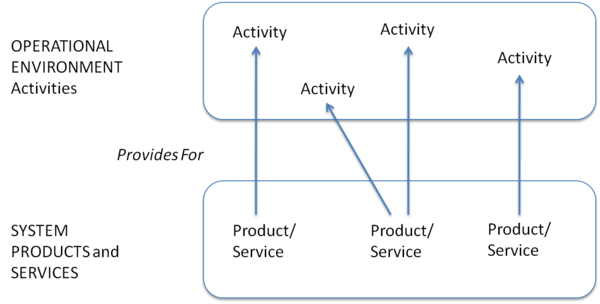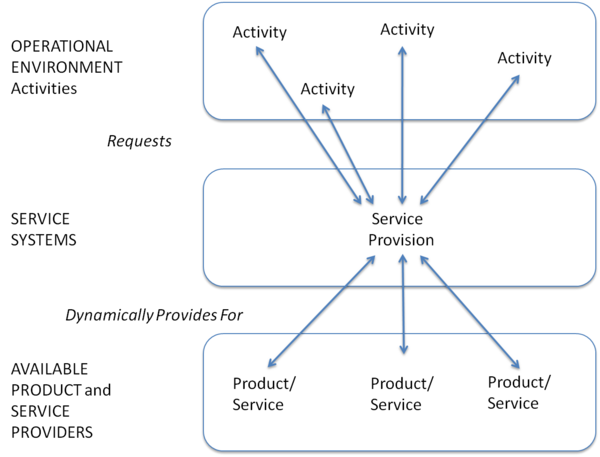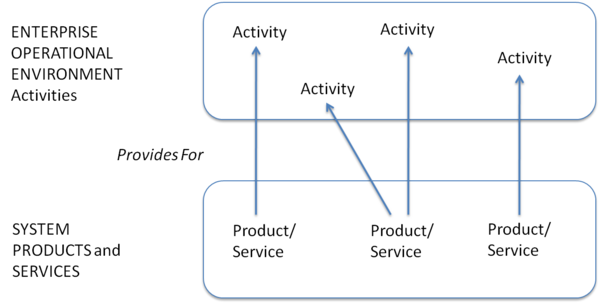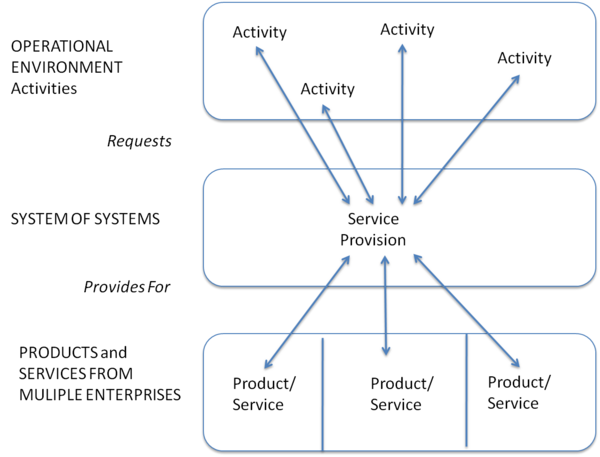Difference between revisions of "Applications of Systems Engineering"
| Line 77: | Line 77: | ||
--[[User:Blawson|Blawson]] 20:36, 15 August 2011 (UTC)-- | --[[User:Blawson|Blawson]] 20:36, 15 August 2011 (UTC)-- | ||
| + | --[[User:Dcarey|Dcarey]] 19:35, 1 September 2011 (UTC) | ||
--[[User:Olwell|Olwell]] | --[[User:Olwell|Olwell]] | ||
Revision as of 19:35, 1 September 2011
This part of the SEBOK focuses on the knowledge of how to apply systems engineering to the creation and life cycle management of various types of systems. In particular, the engineering of product systems , the engineering of service systems , the engineering of an enterprise systems as well as the engineering of systems of systems .
Knowledge Areas
The following Knowledge Areas are included in Part 4:
- Product Systems Engineering
- Service Systems Engineering
- Enterprise Systems Engineering
- Systems of Systems (SoS)
Systems Engineering Application Paradigms
In the introduction to Part 3 Systems Engineering and Management, a paradigm was introduced that provides insight into the fundamental goal of all systems engineering efforts; that is transforming the need for operational capabilities into a supplied product or service. Given this framework, the various knowledge areas of Part 3 have provided deeper insight into how to accomplish systems engineering life cycle-related activities.
The following paradigms provide insight into the primary commonalities and differentiators of the various applications of systems engineering presented in this part. Concerning the commonality, all products and services are developed to provide for the capabilities needed in an operational environment in the form of activities. The supply of the products and services and the nature of the operational environment differentiate the applications.
The paradigm in Figure 1 illustrates the main result of TSE (Traditional Systems Engineering), that is, the supply of products and services that fulfill the capability needs as activities in an operational environment. In TSE, the operational environment is often described by some form of concept of operations (conops) that can include Use Cases (glossary) of the activities of the system in operation.
Figure 1: Product/Service Provisioning
It is important to take into account the binding of the products and services to the activities. As implied by the figure, the operational environmental needs are met by directly binding products and/or services to the needs of one or more of the activities of the operational environment. In a manner consistent with ISO/IEC 15288, the products and services are composed of systems in which hardware, software, and human elements are supplied. Thus a mixture of physical products (often including software) and services such as logistics, help-desk functions, etc., may be provided. The supply of products and services can be a result of a direct acquisition or the result of acquiring products or services that have been provided for a marketplace. Note that the provisioning of products and services when humans are involved (a hospital provides a good example) may even be classified as sociotechnical system .
The paradigm in Figure 2 illustrates the provision of Service Systems. The growth of this model has been stimulated to a large extent due to the widespread availability of IT services such as Service Oriented Architectures (SOA), Software as a System (SaS), and Cloud Computing.
Figure 2: Service System Provisioning
A primary difference between SSE (Service Systems Engineering) and TSE is the Dynamic binding of products and services, potentially from multiple providers, in order to provide a desired service. Thus, from a given service request, the service is dynamically composed. In the background there are a variety of hardware, software, and even human elements that provide the elements of a service. In contrast to an operational environment that is sustained, the service requested may be viewed as a temporary environment established to provide the service and it disappears after the service has been provided.
The paradigm in Figure 3 illustrates the provision of ESE (Enterprise Systems Engineering) to meet the capability needs in the form of enterprise activities.
Figure 3: Engineering of an Enterprise
This form is similar to the TSE with the main difference that the activities of the operational environment typically rely upon services provided by Systems of Processes (both Business Processes and System Life Cycle Processes) that are essential in operating the enterprise. In addition, the products and services that are supplied to the enterprise include those that support their own value added production of products and services as well as their infrastructure systems.
Finally, the paradigm in Figure 4 illustrates the provisioning of products and services by multiple enterprises in forming a System of Systems that is created in order to meet the complex needs of an operational environment. Note: this could be meeting a crisis situation or meeting the needs of a new type of operation where multiple enterprises provide a new form of added value based upon their combined products and services.
Figure 4: System of Systems Provisioning
All of the enterprises that contribute to an SoS are independent and provide value-added products or services that are meaningful individually.
SoSE (System of Systems Engineering), particularly when responding to some form of natural or manmade crisis, is initiated in the form of a request for service in order to meet a complex situation that has arisen. In relationship to the system coupling diagram SoSE involves accelerated engineering of the Respondent System that will interact with the Situation System. Thus, instantiated system assets in the form of products and/or services are supplied from multiple enterprises and quickly integrated in providing the respondent service. In a manner similar to Service Systems, the operational environment disappears when the crises has been handled.
SoSE (System of Systems Engineering) is also applied in merging the operations of multiple enterprises in order to provide some new form of service. In contrast to unplanned crises, this is the result of planned development. The formation of the Department of Homeland Security in the USA is an example. In the private sector, multiple organizations may integrate their enterprise operations in order to meet an opportunity in a new marketplace.
These paradigms have provided an introduction to Part 4 and should be kept in mind as the reader proceeds to understand the detailed description of the application of systems engineering in the Knowledge Areas.
References
Citations
None.
Primary References
No primary references have been identified for version 0.5. Please provide any recommendations on additional references in your review.
Additional References
No additional references have been identified for version 0.5. Please provide any recommendations on additional references in your review.
Article Discussion
Signatures
--Blawson 20:36, 15 August 2011 (UTC)--
--Dcarey 19:35, 1 September 2011 (UTC)
--Olwell



